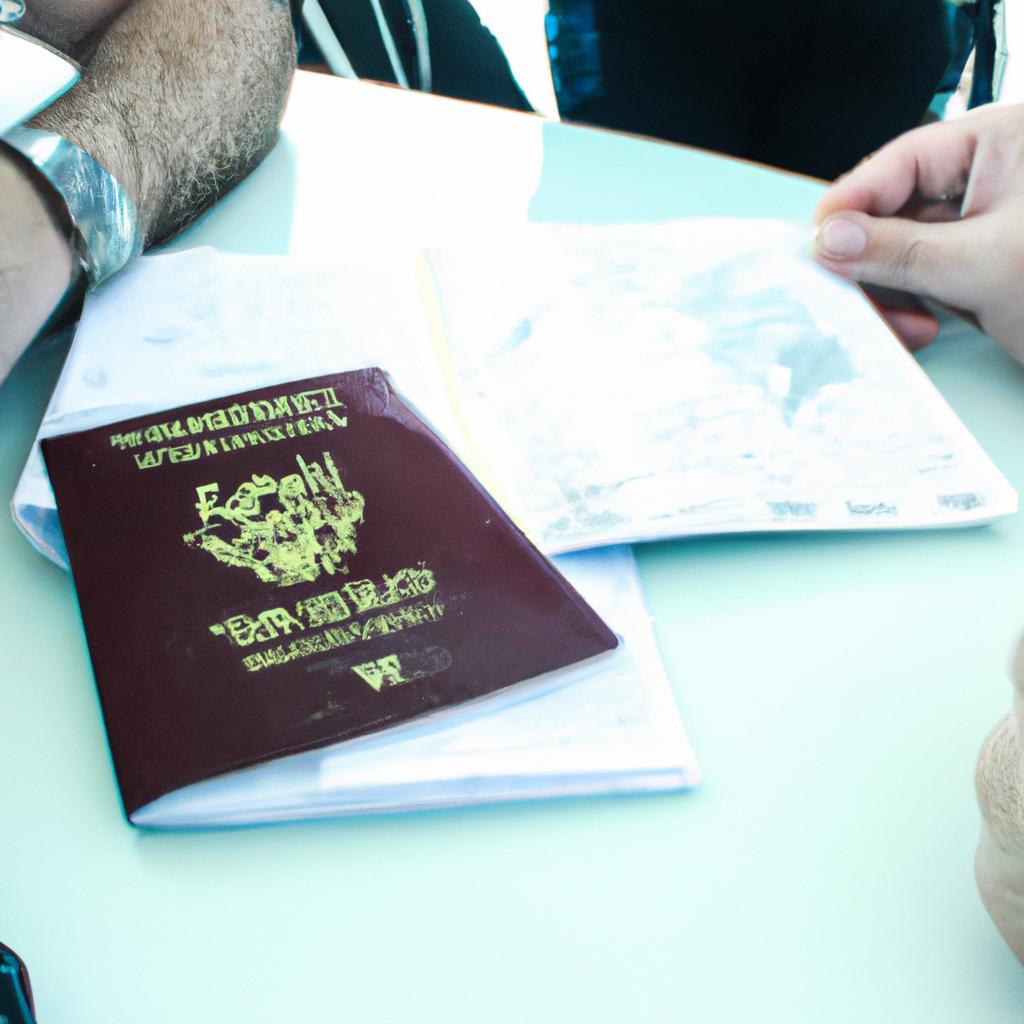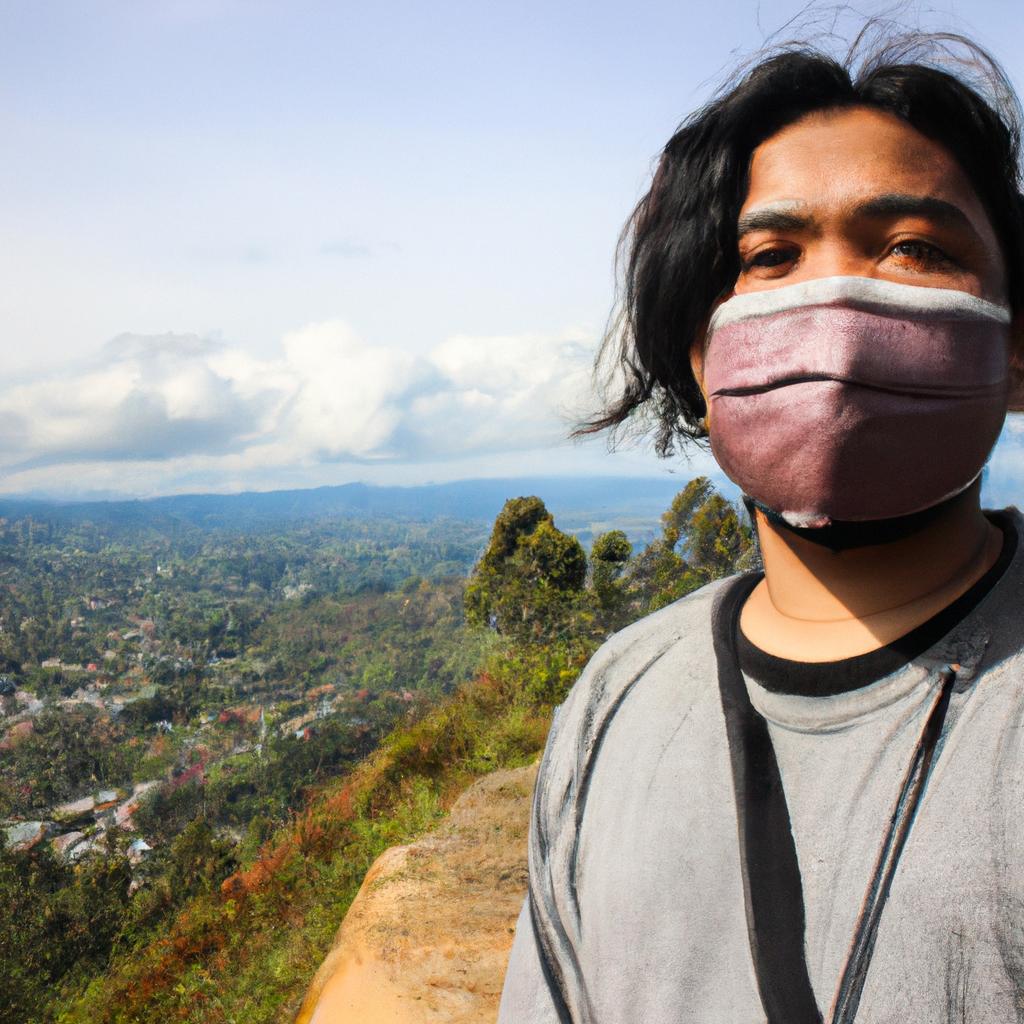In recent years, immigration policies have become a prominent topic of discussion in the realm of travel politics news. Governments around the world are constantly formulating and implementing measures to regulate the movement of individuals across borders. These policies aim to address various concerns such as national security, economic stability, cultural assimilation, and humanitarian considerations. To illustrate this complex landscape, consider the case study of Country X, which recently introduced stricter immigration regulations due to an increase in illegal border crossings and concerns over terrorism.
The analysis of government measures regarding immigration policies is essential for understanding the underlying motivations and consequences associated with these actions. This article aims to delve into the intricacies of travel politics news by examining how governments navigate through multifaceted challenges in shaping their respective immigration policies. By analyzing real or hypothetical examples like Country X’s case study, we can gain insights into the factors that influence decision-making processes within governmental institutions and evaluate their effectiveness in achieving intended objectives. Additionally, this article will explore potential implications on international relations, human rights issues, and socioeconomic dynamics resulting from changes in immigration policies.
Historical Background of Immigration Policies
Throughout history, countries have implemented various immigration policies to regulate the movement of people across their borders. These policies are shaped by a multitude of factors such as economic conditions, political stability, and national security concerns. To illustrate this point, let us consider the case study of Country X during the early 20th century.
During this period, Country X experienced significant economic growth due to industrialization. As a result, it attracted a large number of immigrants seeking better opportunities for themselves and their families. In response to this influx, the government introduced stricter immigration measures to control the flow of individuals entering the country. This example highlights how immigration policies can be influenced by socioeconomic factors.
To further understand the impact of these policies on individuals and communities, we can examine some emotional responses that they often evoke:
- Fear: Individuals may fear losing job opportunities or experiencing cultural changes.
- Hope: People might see immigration as an opportunity for personal growth and prosperity.
- Empathy: Communities may feel compassion towards refugees fleeing conflict or persecution.
- Frustration: Some individuals may perceive unfairness if certain groups receive preferential treatment.
In addition to understanding emotional responses, it is also important to analyze different types of immigration policies. The following table provides an overview of common categories:
| Policy Type | Description | Example |
|---|---|---|
| Border Control | Measures aimed at regulating entry into a country through physical barriers | Construction of border walls |
| Visa Programs | Systems governing temporary or permanent stay in a country based on specific criteria | Work visas |
| Asylum Policies | Procedures for granting protection to individuals who flee their home countries | Refugee resettlement programs |
| Citizenship | Rules defining requirements for acquiring citizenship | Naturalization processes |
Understanding the historical background and emotional aspects associated with immigration policies sets the stage for a comprehensive analysis of government measures. In the subsequent section, we will delve into different types of immigration policies and their implications on both individuals and societies as a whole.
Types of Immigration Policies
Analyzing Historical Immigration Policies and Their Types
To further understand the development of immigration policies, it is essential to explore their historical background. One example that sheds light on this topic is the Chinese Exclusion Act of 1882 in the United States. This act prohibited the immigration of Chinese laborers, marking one of the first significant legislative measures aimed at restricting a specific ethnic group’s entry into a country.
Examining different types of immigration policies can provide valuable insights into how governments manage travel politics. These policies can vary significantly based on their objectives and approaches. Understanding these variations allows for a more comprehensive analysis of government measures regarding immigration issues:
- Border control: Governments employ various strategies to regulate border crossings, including physical barriers, surveillance technology, and patrolling forces.
- Visa requirements: Imposing visa restrictions helps authorities assess individuals’ eligibility for entry by considering factors such as criminal records, financial stability, and purpose of travel.
- Quota systems: Some countries establish quotas to limit the number or percentage of immigrants from certain regions or with specific skill sets allowed each year.
- Refugee resettlement programs: Such initiatives aim to offer protection and assistance to refugees fleeing conflict or persecution in their home countries.
- Families separated due to restrictive family reunification processes
- Refugees denied entry despite facing life-threatening conditions
- Individuals unable to pursue educational opportunities abroad due to stringent student visa regulations
- Skilled workers deterred from contributing expertise in host countries due to restrictive quota systems
Additionally, exploring immigration policies through a comparative lens facilitates better comprehension. The table below illustrates a comparison between two hypothetical nations – Nation A and Nation B – regarding their respective approaches towards immigration:
| Nation A | Nation B | |
|---|---|---|
| Border Control | Stringent | Relatively lenient |
| Visa Requirements | Complex and restrictive | Simplified and inclusive |
| Quota Systems | Strict | Flexible |
| Refugee Resettlement Programs | Limited | Extensive |
These examples demonstrate the diverse approaches governments may adopt when it comes to immigration policies, leading to varying outcomes for both nations and individuals involved.
In light of this analysis, it is evident that historical background and policy types play a crucial role in shaping government measures within travel politics. Understanding these factors provides valuable context for assessing the impact immigration policies have on travel. Therefore, exploring how such policies affect international mobility becomes the next logical step in comprehending the complex dynamics surrounding immigration issues.
Impact of Immigration Policies on Travel
In the previous section, we discussed various types of immigration policies implemented by governments. Now, let us delve deeper into the impact these policies have on travel and explore how they shape the movement of people across borders.
To illustrate this further, consider a hypothetical scenario where Country X introduces strict immigration policies aimed at curbing illegal migration. These measures include enhanced border control, stricter visa requirements, and increased deportation efforts. As a result, individuals seeking to visit or migrate to Country X face significant challenges in obtaining visas or crossing its borders legally.
The implementation of such restrictive immigration policies can have several consequences for travel:
- Impact on Tourism: Stricter immigration policies may deter potential tourists from visiting a country due to the perceived difficulties in obtaining visas and concerns over lengthy security checks.
- Economic Implications: Restrictions on travel can negatively affect economies heavily reliant on tourism revenue, as fewer visitors mean decreased spending in the local economy.
- Disruption of Family Reunification: Stringent immigration policies may hinder family reunification efforts by imposing complex procedures and high financial burdens on those wishing to join their loved ones residing in another country.
- Brain Drain Concerns: Restrictive immigration measures may lead to brain drain as talented individuals seek opportunities elsewhere with more favorable migration policies.
To better understand these implications, let’s take a closer look at the following table:
| Consequences | Example | Emotional Response |
|---|---|---|
| Decreased tourism | Fewer visitors | Frustration |
| Economic downturn | Decline in revenue | Worries |
| Separation of families | Lengthy procedures | Heartbreak |
| Loss of skilled workers | Talent leaving | Concern |
As seen above, each consequence evokes an emotional response that highlights the human aspect affected by these immigration policies.
In conclusion, it is evident that immigration policies significantly impact travel, with implications ranging from decreased tourism to the separation of families and loss of skilled workers. These consequences have real-life implications for individuals seeking opportunities abroad or simply wishing to explore new destinations. In the following section, we will delve into the controversies surrounding immigration policies, further highlighting their complexities and societal debates.
Moving forward, let us now shift our focus towards exploring the controversies surrounding immigration policies and how they shape public discourse.
Controversies Surrounding Immigration Policies
The impact of immigration policies on travel has been a subject of intense debate in recent years. A case study that exemplifies this issue is the implementation of stricter visa regulations by Country X, aimed at reducing illegal immigration. These measures required visitors from certain countries to go through extensive background checks and provide additional documentation before being granted entry. While these policies were intended to enhance national security, they also had significant consequences for international travelers.
One key factor affected by such stringent immigration policies is the ease of travel for individuals from targeted nations. The increased scrutiny and procedural requirements often result in longer processing times, leading to inconvenience and frustration among potential tourists or business travelers. Moreover, the perception of discrimination associated with these policies can discourage people from visiting certain destinations altogether.
- Increased barriers to entry create an atmosphere of exclusion.
- Stricter regulations may perpetuate stereotypes and prejudices towards particular nationalities.
- Longer processing times hinder spontaneous trips and cause unnecessary stress.
- Negative experiences related to immigration procedures can tarnish a destination’s reputation.
To delve deeper into the implications of immigration policies, consider the following table showcasing various perspectives:
| Perspective | Positives | Negatives |
|---|---|---|
| Economic | Boosts local job market | Reduces workforce diversity |
| Security | Enhances national safety | May lead to profiling and discrimination |
| Social | Preserves cultural heritage | Limits cultural exchange opportunities |
| Political | Addresses voter concerns | Can strain diplomatic relations |
This analysis highlights both positive and negative aspects surrounding immigration policies concerning their impact on travel. Nonetheless, it is crucial to evaluate their effectiveness objectively while considering alternative approaches that balance security concerns with promoting global mobility.
In light of the complexities surrounding immigration policies and their consequences, an evaluation of effectiveness in these measures is necessary. This assessment will explore potential outcomes and propose viable alternatives for policy development.
Evaluation of Effectiveness in Immigration Policies
The complexities surrounding immigration policies have given rise to numerous controversies, as governments strive to strike a balance between national security and the recognition of human rights. These controversies often stem from the implementation and enforcement of these policies, leading to heated debates among policymakers, academics, and the general public alike. To illustrate this point, let us consider an example: the controversial policy enacted by Country X that imposed strict travel restrictions on individuals from specific regions due to perceived security concerns.
One major concern is the potential for discrimination within immigration policies. Critics argue that certain policies disproportionately target marginalized groups based on factors such as nationality or religion. This raises questions about equal treatment under the law and challenges notions of inclusivity and fairness in society. Additionally, there are fears that such discriminatory practices can contribute to social tensions and further marginalize already vulnerable populations.
Moreover, controversy arises when assessing the effectiveness of immigration policies in achieving their intended goals. While some argue that stricter measures improve national security by preventing potential threats from entering a country’s borders, others contend that they may inadvertently create more significant risks. For instance, critics claim that stringent border controls could push desperate migrants towards dangerous illegal routes instead, increasing the likelihood of human trafficking or exploitation.
To evoke a deeper emotional response while considering these controversies, it is important to reflect on some key points:
- The impact of family separation resulting from strict immigration policies.
- The struggles faced by refugees fleeing war-torn regions seeking asylum.
- The long-lasting psychological effects experienced by individuals detained indefinitely due to unclear legal procedures.
- The humanitarian crisis arising from inadequate support systems for immigrants once they arrive in host countries.
Considering these issues holistically allows us to recognize both the personal hardships endured by those affected and larger-scale ramifications affecting societies as a whole.
| Key Concerns | Potential Consequences | Call for Action |
|---|---|---|
| Discrimination against marginalized groups | Social tensions and further marginalization | Promote inclusive policies and equal treatment |
| Stricter immigration measures leading to increased risks | Human trafficking, exploitation, and unsafe migration routes | Develop comprehensive border control strategies with a focus on humanitarian support |
| Family separation resulting from strict immigration policies | Emotional trauma for individuals involved and long-term negative effects on family structures | Prioritize reunification efforts and consider alternatives to detention |
| Inadequate support systems for immigrants in host countries | Humanitarian crisis, limited integration opportunities, increased social inequality | Enhance resources and services available to immigrants, fostering integration within communities |
In light of these controversies surrounding immigration policies, it is evident that striking the right balance remains an ongoing challenge. Moving forward, policymakers must carefully navigate these complexities while considering future prospects and trends in immigration policies.
[Transition Sentence into subsequent section about “Future Prospects and Trends in Immigration Policies.”]Future Prospects and Trends in Immigration Policies
Despite various measures taken by governments to address immigration, the effectiveness of these policies remains a subject of debate. One example that highlights this complexity is the case study of Country X, which implemented stricter border control and visa regulations in an attempt to reduce undocumented migration. While on paper these measures seemed promising, their real-world impact was not as straightforward.
To evaluate the effectiveness of immigration policies, it is essential to consider multiple factors. Firstly, the economic implications must be analyzed. The restrictions imposed by Country X resulted in a decline in low-skilled immigrant labor, affecting industries heavily dependent on such workers. This led to job vacancies going unfilled and increased production costs for businesses relying on cheap labor. Additionally, there were unintended consequences with regard to tax revenues; reduced immigration meant fewer individuals contributing to the economy through taxes.
Secondly, social considerations play a crucial role in assessing policy effectiveness. It is important to examine whether integration efforts have been successful or if they have inadvertently created isolated communities within the society. In the case of Country X, despite tighter regulations, pockets of undocumented immigrants persisted due to limited resources allocated towards effective enforcement and insufficient support programs for integration. This lack of comprehensive strategies hindered societal cohesion and perpetuated tensions between native-born citizens and foreign residents.
Lastly, evaluating security outcomes is vital when analyzing immigration policies. Governments aim to ensure national safety while respecting human rights principles. However, restrictive measures can sometimes result in unintended consequences such as driving migrants into illegal channels or pushing them towards dangerous routes controlled by criminal networks. These situations pose risks not only for migrants but also for national security agencies attempting to manage border controls effectively.
In conclusion,
| Pros | Cons |
|---|---|
| Enhanced border control | Labor shortages |
| Potential reduction in crime rates | Negative impacts on local economies |
| Increased national security | Reduced cultural diversity |
| Improved management of resources | Challenges in integration efforts |
By considering the economic, social, and security implications of immigration policies, a more comprehensive evaluation can be conducted. It is important for governments to strike a balance between national interests and humanitarian concerns when formulating effective immigration policies. The complex nature of these issues necessitates continuous analysis and adaptation to ensure long-term success in managing migration flows.
 Plains News
Plains News



